A Bias in the Prediction of Tastes - Carnegie Mellon University
A Bias in the Prediction of Tastes - Carnegie Mellon University
A Bias in the Prediction of Tastes - Carnegie Mellon University
Create successful ePaper yourself
Turn your PDF publications into a flip-book with our unique Google optimized e-Paper software.
The Economic Journal, 105 (July), 929-937. ? Royal Economic Society I995. Published by Blackwell<br />
Publishers, io8 Cowley Road, Oxford OX4 iJF, UK and 238 Ma<strong>in</strong> Street, Cambridge, MA 02I42, USA.<br />
A BIAS IN THE PREDICTION OF TASTES*<br />
George Loewenste<strong>in</strong> and Daniel Adler<br />
Recent research has documented an 'endowment effect' whereby people become more attached to<br />
objects <strong>the</strong>y receive than would be predicted from <strong>the</strong>ir prior desire to possess <strong>the</strong> object. In two<br />
experiments, we test whe<strong>the</strong>r people are aware <strong>of</strong> <strong>the</strong> effect - whe<strong>the</strong>r <strong>the</strong>y realise that <strong>the</strong>y will<br />
become attached to an object once <strong>the</strong>y receive it. In both experiments, subjects without an object<br />
underestimated how much <strong>the</strong>y would value <strong>the</strong> object when <strong>the</strong>y received it.<br />
Although <strong>the</strong> standard economic <strong>the</strong>ory <strong>of</strong> consumer preference assumes fixed<br />
tastes, <strong>the</strong> idea that tastes change over time is not controversial. Numerous<br />
'habit formation' models have been proposed which assume that current<br />
consumption <strong>in</strong>fluences future tastes (Duesenberry, I 952; Pollak, I 970; Stigler<br />
and Becker, I977). These models have been applied to such diverse phenomena<br />
as <strong>the</strong> development <strong>of</strong> tastes for music and food, substance addiction (Becker<br />
and Murphy, I 990) , and <strong>the</strong> surpris<strong>in</strong>gly high rate <strong>of</strong> return on equities relative<br />
to fixed-<strong>in</strong>come securities (e.g. Constant<strong>in</strong>edes, I990).<br />
Although it is more complicated to model than fixed tastes, <strong>the</strong>re is noth<strong>in</strong>g<br />
<strong>in</strong>tr<strong>in</strong>sically irrational about habit formation as long as economic agents can<br />
predict without bias <strong>the</strong> effect <strong>of</strong> <strong>the</strong>ir current behaviour on <strong>the</strong>ir own future<br />
tastes. If people are aware <strong>of</strong> <strong>the</strong> effect <strong>of</strong> <strong>the</strong>ir actions on <strong>the</strong>ir own future<br />
tastes, <strong>the</strong>y can adjust <strong>the</strong>ir consumption <strong>in</strong> a rational manner - e.g. by<br />
desist<strong>in</strong>g from crack based on anticipation <strong>of</strong> future disutility from addiction.<br />
There is some evidence, however, po<strong>in</strong>t<strong>in</strong>g to situations <strong>in</strong> which people<br />
systematically mispredict <strong>the</strong>ir own tastes. For example Ausubel (i99i) noted<br />
that large numbers <strong>of</strong> credit card users expect to ma<strong>in</strong>ta<strong>in</strong> a zero credit balance<br />
but fail to do so - apparently underestimat<strong>in</strong>g <strong>the</strong>ir own future desire for<br />
spend<strong>in</strong>g. This self-forecast<strong>in</strong>g error can expla<strong>in</strong> <strong>the</strong> downward stick<strong>in</strong>ess <strong>of</strong><br />
credit card <strong>in</strong>terest rates s<strong>in</strong>ce consumers who expect to ma<strong>in</strong>ta<strong>in</strong> zero card<br />
balances will not care about credit card <strong>in</strong>terest rates. A similar pattern occurs<br />
<strong>in</strong> connection with consumer rebate programmes; consumer purchase decisions<br />
are quite sensitive to rebate <strong>of</strong>fers, but very few consumers ultimately send <strong>in</strong><br />
<strong>the</strong> forms required to obta<strong>in</strong> <strong>the</strong> rebate (Tat et al. I988).<br />
Our specific focus is on whe<strong>the</strong>r people are able to predict changes <strong>in</strong> <strong>the</strong>ir<br />
own tastes caused by <strong>the</strong> 'endowment effect' (Thaler, I980). The endowment<br />
effect refers to <strong>the</strong> tendency for people to value an object more highly if <strong>the</strong>y<br />
possess it than <strong>the</strong>y would value <strong>the</strong> same object if <strong>the</strong>y did not. In <strong>the</strong> typical<br />
demonstration <strong>of</strong> <strong>the</strong> endowment effect (see, e.g. Kahneman et al. I990), one<br />
group <strong>of</strong> subjects (sellers) are endowed with an object and are given <strong>the</strong> option<br />
<strong>of</strong> trad<strong>in</strong>g it for various amounts <strong>of</strong> cash; ano<strong>the</strong>r group (choosers) are not<br />
given <strong>the</strong> object but are given a series <strong>of</strong> choices between gett<strong>in</strong>g <strong>the</strong> object or<br />
* We thank Max Bazerman, Baruch Fischh<strong>of</strong>f, Col<strong>in</strong> Camerer, Drazen Prelec, and Shane Frederick for<br />
helpful comments and suggestions, and T<strong>in</strong>a Diekman for assistance <strong>in</strong> runn<strong>in</strong>g <strong>the</strong> experiments. The idea<br />
for <strong>the</strong> first experiments arose <strong>in</strong> a discussion with Daniel Kahneman.<br />
[ 929 ]
930 THE ECONOMIC JOURNAL [JULY<br />
gett<strong>in</strong>g various amounts <strong>of</strong> cash. Although <strong>the</strong> objective wealth position <strong>of</strong> <strong>the</strong><br />
two groups is identical, as are <strong>the</strong> choices <strong>the</strong>y face, endowed subjects hold out<br />
for significantly more money than those who are not endowed. As Tversky and<br />
Kahneman (i 991 ) have shown, <strong>the</strong> endowment effect implies that <strong>in</strong>difference<br />
curves shift <strong>in</strong> a systematic manner when <strong>in</strong>dividuals acquire goods - <strong>in</strong>creas<strong>in</strong>g<br />
<strong>the</strong> valuation <strong>of</strong> <strong>the</strong> endowed good relative to all o<strong>the</strong>r goods. Thus, <strong>the</strong><br />
endowment effect can be viewed as a type <strong>of</strong> endogenous taste-change.<br />
Tversky and Kahneman analyse <strong>the</strong> effect <strong>of</strong> endowments on preferences<br />
with a 'reference-dependent preference structure' that <strong>in</strong>dexes <strong>the</strong> standard<br />
preference relations (>-, X, , etc.) accord<strong>in</strong>g to <strong>the</strong> <strong>in</strong>dividual's po<strong>in</strong>t <strong>of</strong><br />
reference (typically <strong>the</strong> current asset position). For example, x -ry <strong>in</strong>dicates<br />
that an <strong>in</strong>dividual with reference position r is <strong>in</strong>different between alternatives<br />
x and y. The sell<strong>in</strong>g price (s) and choice value (c) estimated <strong>in</strong> <strong>the</strong> experimental<br />
setup just described are represented <strong>in</strong> equations i and 2 respectively, where<br />
<strong>the</strong> first argument <strong>of</strong> each pair <strong>in</strong>dicates <strong>the</strong> <strong>in</strong>dividual's level <strong>of</strong> wealth, <strong>the</strong><br />
second designates possession (i) or nonpossession (o) <strong>of</strong> <strong>the</strong> object, and <strong>the</strong><br />
preference relation is subscripted accord<strong>in</strong>g to whe<strong>the</strong>r <strong>the</strong> decision maker is <strong>in</strong><br />
possession <strong>of</strong> <strong>the</strong> object. I) (w + s) (I)<br />
(W) I) o (W + CO) (2)<br />
The endowment effect implies s > c.<br />
To accommodate predictions <strong>of</strong> preferences with<strong>in</strong> this framework, we<br />
generalise <strong>the</strong> notation by subscript<strong>in</strong>g <strong>the</strong> preference relation by <strong>the</strong> asset<br />
position which <strong>the</strong> <strong>in</strong>dividual is attempt<strong>in</strong>g to predict, and superscript<strong>in</strong>g it by<br />
<strong>the</strong> <strong>in</strong>dividual's current reference level. Thus, for an <strong>in</strong>dividual with asset<br />
pos'tion s, -r represents <strong>the</strong> <strong>in</strong>difference relations she would expect to prevail<br />
if her asset position were r <strong>in</strong>stead <strong>of</strong> s.1<br />
In <strong>the</strong> experiments presented below, we asked subjects to predict <strong>the</strong>ir own<br />
sell<strong>in</strong>g price for an object <strong>the</strong>y did not have - i.e. to predict a sell<strong>in</strong>g price, s',<br />
as def<strong>in</strong>ed byw,<br />
)<br />
(w+s',o)<br />
(W,<br />
I ) 1 (W 3) ,O<br />
If subjects predict <strong>the</strong>ir own sell<strong>in</strong>g prices without bias, <strong>the</strong>n, on average, s' = s.<br />
Our prediction is that subjects will underestimate s - i.e. s' g s.<br />
The endowment effect has several advantages as <strong>the</strong> focus <strong>of</strong> a study <strong>of</strong> tastechange<br />
prediction. First, <strong>the</strong> effect operates very rapidly so that, unlike, for<br />
example, changes <strong>in</strong> <strong>the</strong> taste for classical music, it can be studied <strong>in</strong> a s<strong>in</strong>gle<br />
experimental session. Second, discovery <strong>of</strong> a bias <strong>in</strong> predict<strong>in</strong>g <strong>the</strong> impact <strong>of</strong> <strong>the</strong><br />
endowment effect would have far-reach<strong>in</strong>g implications for economics. The<br />
endowment effect refers to <strong>the</strong> impact on tastes <strong>of</strong> merely acquir<strong>in</strong>g a good.<br />
S<strong>in</strong>ce many economic decisions, <strong>in</strong>clud<strong>in</strong>g most decisions <strong>in</strong>volv<strong>in</strong>g consumer<br />
choice, <strong>in</strong>volve acquisitions, documentation <strong>of</strong> a bias <strong>in</strong> <strong>the</strong> prediction <strong>of</strong> <strong>the</strong><br />
endowment effect would call <strong>in</strong>to question <strong>the</strong> rationality <strong>of</strong> a wide range <strong>of</strong><br />
economic behaviour. F<strong>in</strong>ally, we believed that <strong>the</strong>re was a high likelihood <strong>of</strong><br />
observ<strong>in</strong>g a prediction bias <strong>in</strong> this particular doma<strong>in</strong>. This <strong>in</strong>tuition is based<br />
1 Under <strong>the</strong> generalised notation, <strong>the</strong> conventional endowment effect can be expressed as: (w, i)<br />
o), and (w, i) (w (W+c,o), with s > c.<br />
K Royal Economic Society I995<br />
-<br />
(w + s,
I995] THE PREDICTION OF TASTES 93I<br />
on, first, <strong>the</strong> surpris<strong>in</strong>gly long time it has taken social scientists to discover <strong>the</strong><br />
effect, given its magnitude and robustness; second, <strong>the</strong> fact that <strong>the</strong> endowment<br />
effect disappears when people make valuation decisions on behalf <strong>of</strong> ano<strong>the</strong>r<br />
person, as if <strong>the</strong>y are not aware that o<strong>the</strong>rs will get attached to objects <strong>in</strong> <strong>the</strong>ir<br />
possession (Marshall et al. I987); and third, <strong>the</strong> fact that o<strong>the</strong>r studies have<br />
found that people tend to underestimate how quickly <strong>the</strong>y will adapt to<br />
changed circumstances such as w<strong>in</strong>n<strong>in</strong>g a lottery or becom<strong>in</strong>g paraplegic<br />
(Brickman et al. I978) - i.e. that <strong>the</strong>y underestimate <strong>the</strong> impact <strong>of</strong> reference<br />
po<strong>in</strong>t shifts.<br />
I. EXPERIMENT I<br />
The first experiment was designed to test whe<strong>the</strong>r subjects without an object<br />
could predict how attached <strong>the</strong>y would become if <strong>the</strong>y were endowed with it.<br />
We first elicited hypo<strong>the</strong>tical sell<strong>in</strong>g prices for an object from unendowed<br />
subjects <strong>the</strong>n endowed <strong>the</strong>m with <strong>the</strong> object and elicited an actual sell<strong>in</strong>g price.<br />
Subjects were 27 undergraduates enrolled <strong>in</strong> a core humanities class at<br />
<strong>Carnegie</strong> <strong>Mellon</strong> <strong>University</strong> and 42 adults enrolled <strong>in</strong> two even<strong>in</strong>g classes <strong>in</strong><br />
f<strong>in</strong>ance at <strong>the</strong> <strong>University</strong> <strong>of</strong> Pittsburgh. In each class, <strong>the</strong> experimenter held up<br />
a mug engraved with <strong>the</strong> school logo for <strong>the</strong> students to see. A different style<br />
<strong>of</strong> mug was used at <strong>Carnegie</strong> <strong>Mellon</strong> and at <strong>the</strong> <strong>University</strong> <strong>of</strong> Pittsburgh. A<br />
form was <strong>the</strong>n randomly distributed to approximately half <strong>of</strong> <strong>the</strong> students <strong>in</strong><br />
each class. The form asked <strong>the</strong> students to imag<strong>in</strong>e that <strong>the</strong>y possessed <strong>the</strong> mug<br />
on display and to predict whe<strong>the</strong>r <strong>the</strong>y would be will<strong>in</strong>g to exchange <strong>the</strong> mug<br />
for various amounts <strong>of</strong> money. It was worded as follows:<br />
We are <strong>in</strong>terested <strong>in</strong> your op<strong>in</strong>ion about <strong>the</strong> mug displayed at <strong>the</strong> front <strong>of</strong><br />
<strong>the</strong> room. Imag<strong>in</strong>e that we gave you a mug exactly like <strong>the</strong> one you can<br />
see, and that we gave you <strong>the</strong> opportunity to keep it or trade it for some<br />
money. Below are a series <strong>of</strong> l<strong>in</strong>es marked 'Keep mug__ Trade it for<br />
$ amount .' On each l<strong>in</strong>e check whe<strong>the</strong>r you th<strong>in</strong>k that you would<br />
prefer to keep <strong>the</strong> mug or to trade it <strong>in</strong> for <strong>the</strong> amount <strong>of</strong> money written<br />
on <strong>the</strong> l<strong>in</strong>e. Check one or <strong>the</strong> o<strong>the</strong>r on every l<strong>in</strong>e.<br />
The rema<strong>in</strong>der <strong>of</strong> <strong>the</strong> page consisted <strong>of</strong> 40 l<strong>in</strong>es each conta<strong>in</strong><strong>in</strong>g a choice<br />
between keep<strong>in</strong>g <strong>the</strong> mug or trad<strong>in</strong>g it for an amount <strong>of</strong> money that ranged<br />
from 25 cents to io dollars <strong>in</strong> $0.25 <strong>in</strong>crements. The experimenter waited until<br />
all subjects with a form had completed it. Next, all subjects were presented with<br />
a mug and given a second form which actually provided <strong>the</strong> opportunity to<br />
exchange <strong>the</strong> mug for cash. The <strong>in</strong>structions for <strong>the</strong> second form were directly<br />
analogous to those used <strong>in</strong> <strong>the</strong> prediction form, but made it clear that one <strong>of</strong><br />
<strong>the</strong>ir choices would count. Subjects were told that <strong>the</strong>y would receive <strong>the</strong><br />
option <strong>the</strong>y had circled on one <strong>of</strong> <strong>the</strong> l<strong>in</strong>es - which l<strong>in</strong>e had been determ<strong>in</strong>ed<br />
<strong>in</strong> advance by <strong>the</strong> experimenter.<br />
The experimental design creates two groups <strong>of</strong> subjects, one that completed<br />
<strong>the</strong> prediction form prior to receiv<strong>in</strong>g a mug, and <strong>the</strong> o<strong>the</strong>r that did not. It<br />
allows us to conduct both a between- and with<strong>in</strong>-subject analysis <strong>of</strong> prediction<br />
accuracy. The with<strong>in</strong>-subject analysis compares <strong>the</strong> prelim<strong>in</strong>ary valuation<br />
K Royal Economic Society I995
932 THE ECONOMIC JOURNAL [JULY<br />
predictions <strong>of</strong> <strong>the</strong> group that completed <strong>the</strong> first form with <strong>the</strong>ir subsequent<br />
actual valuations. The between-subject test compares those predictions with<br />
<strong>the</strong> actual valuations <strong>of</strong> <strong>the</strong> group that did not make <strong>in</strong>itial predictions. The<br />
between-subject comparison was <strong>in</strong>cluded <strong>in</strong> case mak<strong>in</strong>g an <strong>in</strong>itial prediction<br />
<strong>in</strong>fluenced subjects' subsequent choices, <strong>in</strong> which case any bias would have<br />
been attenuated <strong>in</strong> <strong>the</strong> with<strong>in</strong>-subject comparison.<br />
I. I Results<br />
Results for <strong>the</strong> two <strong>University</strong> <strong>of</strong> Pittsburgh classes were similar, so <strong>the</strong>ir data<br />
are aggregated. Three <strong>University</strong> <strong>of</strong> Pittsburgh subjects gave nonmonotonic<br />
responses to both valuation questions, render<strong>in</strong>g <strong>the</strong>ir data uncodable, and two<br />
provided useful predictions, but uncodable actual valuations. All five subjects<br />
are excluded from <strong>the</strong> analyses. The mean m<strong>in</strong>imum sell<strong>in</strong>g values for <strong>the</strong> two<br />
<strong>in</strong>stitutions are shown <strong>in</strong> Table i. For each university group, <strong>the</strong> first l<strong>in</strong>e shows<br />
<strong>the</strong> mean predicted and actual sell<strong>in</strong>g price <strong>of</strong> <strong>the</strong> prediction group. The<br />
second l<strong>in</strong>e shows <strong>the</strong> actual sell<strong>in</strong>g price for subjects who did not previously<br />
predict <strong>the</strong>ir own sell<strong>in</strong>g price.<br />
Table i<br />
Predicted and Actual Valuation <strong>of</strong> <strong>the</strong> Mug<br />
Number <strong>of</strong> <strong>Prediction</strong> Actual<br />
Group/condition subjects <strong>of</strong> valuation valuation<br />
<strong>Carnegie</strong> <strong>Mellon</strong><br />
<strong>University</strong><br />
<strong>Prediction</strong> I4 $3.73 $5.40<br />
-<br />
No prediction I3<br />
~~~~~~~(o040I (o.65)<br />
- $6.46<br />
(0.54)<br />
<strong>University</strong> <strong>of</strong> Pittsburgh<br />
<strong>Prediction</strong> 22 $3.27 $4.56<br />
No prediction I7<br />
(0-48)<br />
-<br />
(0.59)<br />
$4.98<br />
(0.53)<br />
Std. errors <strong>in</strong> paren<strong>the</strong>ses.<br />
Actual sell<strong>in</strong>g prices differed between <strong>the</strong> two universities, probably because<br />
different mugs were used. More <strong>in</strong>terest<strong>in</strong>gly, <strong>the</strong>re was substantial underesti-<br />
mation <strong>of</strong> sell<strong>in</strong>g prices <strong>in</strong> both university groups, both with<strong>in</strong> and between<br />
subjects. With<strong>in</strong> subjects, those who completed <strong>the</strong> first form substantially<br />
underestimated <strong>the</strong>ir own subsequent sell<strong>in</strong>g prices. For <strong>the</strong> <strong>Carnegie</strong> <strong>Mellon</strong><br />
group, mean actual valuations were $i.67 greater than predicted valuations<br />
(t( I 3) = 2-85 p < O002) ; for <strong>the</strong> <strong>University</strong> <strong>of</strong> Pittsburgh group <strong>the</strong>y were greater<br />
by $I.I7 (t(i6) = 3-2, p < O-OI).<br />
Underprediction <strong>of</strong> value is also evident <strong>in</strong> <strong>the</strong> between-subjects comparison<br />
<strong>of</strong> <strong>the</strong> first group's predicted sell<strong>in</strong>g price and <strong>the</strong> second group's actual sell<strong>in</strong>g<br />
price. The mean difference between <strong>the</strong> predictions <strong>of</strong> <strong>the</strong> first group and <strong>the</strong><br />
valuations <strong>of</strong> <strong>the</strong> second was $2.73 (t(25) = 4 I, p < 0o0005) for <strong>the</strong> <strong>Carnegie</strong><br />
? Royal Economic Society I995
I995] THE PREDICTION OF TASTES 933<br />
<strong>Mellon</strong> group, and$ I .59 (t(35) = 2t I, p < o0os) for <strong>the</strong> <strong>University</strong> <strong>of</strong> Pittsburgh<br />
group. Mug valuations <strong>of</strong> <strong>the</strong> group which did not make a prediction were<br />
higher, but not significantly so, than those <strong>of</strong> <strong>the</strong> group which did make a<br />
prediction, suggestive <strong>of</strong> a weak anchor<strong>in</strong>g effect.<br />
II. EXPERIMENT 2<br />
A limitation <strong>of</strong> <strong>the</strong> first study is that it was not '<strong>in</strong>centive compatible' because<br />
subjects had no <strong>in</strong>centive to provide accurate predictions <strong>of</strong> <strong>the</strong>ir own sell<strong>in</strong>g<br />
prices (although, by <strong>the</strong> same token, <strong>the</strong>re was no <strong>in</strong>centive for mis-<br />
representation). The second experiment avoided this problem by <strong>in</strong>form<strong>in</strong>g<br />
subjects that <strong>the</strong>y had a 50?% chance <strong>of</strong> gett<strong>in</strong>g a mug and elicit<strong>in</strong>g a sell<strong>in</strong>g<br />
price that would apply if <strong>the</strong>y got a mug. Our prediction was that subjects who<br />
only had a 50 % chance <strong>of</strong> gett<strong>in</strong>g a mug would not feel endowed and, like <strong>the</strong><br />
prediction subjects <strong>in</strong> <strong>the</strong> previous experiment, would underestimate <strong>the</strong> sell<strong>in</strong>g<br />
price that <strong>the</strong>y would want to prevail if <strong>the</strong>y did get a mug.<br />
A second limitation <strong>of</strong> <strong>the</strong> first study was that it did not elicit choice prices<br />
from subjects, so it was impossible to determ<strong>in</strong>e where <strong>the</strong> predicted sell<strong>in</strong>g<br />
price lay on <strong>the</strong> cont<strong>in</strong>uum between choice values and actual sell<strong>in</strong>g prices. If<br />
subjects predict <strong>the</strong>ir own sell<strong>in</strong>g prices perfectly, <strong>the</strong>n we would observe s' = s<br />
(as def<strong>in</strong>ed <strong>in</strong> equations (I )-(3)); if <strong>the</strong>y are completely unable to predict <strong>the</strong><br />
effect <strong>of</strong> possess<strong>in</strong>g <strong>the</strong> object on <strong>the</strong>ir preferences, <strong>the</strong>n we would anticipate<br />
s= c - i.e. that predicted sell<strong>in</strong>g prices will correspond to choice prices. To<br />
assess where <strong>the</strong>ir predictions lie on this cont<strong>in</strong>uum, we can construct an <strong>in</strong>dex<br />
<strong>of</strong> prediction bias, /1, def<strong>in</strong>ed by:<br />
(s-s') (4)<br />
, will equal o for <strong>in</strong>dividuals who predict <strong>the</strong>ir own sell<strong>in</strong>g prices perfectly, and<br />
I for those who are completely unable to predict <strong>the</strong> effect <strong>of</strong> be<strong>in</strong>g endowed<br />
on <strong>the</strong>ir valuation <strong>of</strong> <strong>the</strong> object. Note that this <strong>in</strong>dex reflects only <strong>the</strong> degree <strong>of</strong><br />
prediction bias, and not <strong>the</strong> magnitude <strong>of</strong> <strong>the</strong> endowment effect which some<br />
people view as a type <strong>of</strong> bias <strong>in</strong> its own right.<br />
II.I Method<br />
Two executive education classes at Northwestern <strong>University</strong> with a total <strong>of</strong> I o6<br />
students were each randomly assigned to two experimental groups which were<br />
isolated <strong>in</strong> separate rooms. In <strong>the</strong> control condition, a co<strong>in</strong> was flipped for each<br />
subject and subjects who called it correctly were given a mug emblazoned with<br />
<strong>the</strong> school logo. Sell<strong>in</strong>g prices were elicited from those who obta<strong>in</strong>ed a mug,<br />
and choice prices from those who did not, us<strong>in</strong>g forms that were analogous to<br />
those used to elicit sell<strong>in</strong>g prices <strong>in</strong> <strong>the</strong> first experiment.<br />
For <strong>the</strong> experimental group, <strong>the</strong> identical type <strong>of</strong> mug was displayed at <strong>the</strong><br />
front <strong>of</strong> <strong>the</strong> room, and subjects were told that <strong>the</strong>re was a 50?% chance <strong>of</strong><br />
receiv<strong>in</strong>g one, based on whe<strong>the</strong>r <strong>the</strong>y correctly called a co<strong>in</strong> flip. Prior to <strong>the</strong><br />
co<strong>in</strong> flip, sell<strong>in</strong>g prices were elicited, which subjects were told would apply if<br />
K Royal Economic Society I995
934 THE ECONOMIC JOURNAL [JULY<br />
<strong>the</strong>y called <strong>the</strong> flip correctly and got a mug.2 After provid<strong>in</strong>g sell<strong>in</strong>g prices,<br />
subjects <strong>in</strong>dividually called a co<strong>in</strong> toss and were given a mug if <strong>the</strong>y called it<br />
correctly. F<strong>in</strong>ally, those who received a mug were asked whe<strong>the</strong>r <strong>the</strong>y would<br />
like to revise <strong>the</strong>ir sell<strong>in</strong>g price (although <strong>the</strong>y were not actually allowed to do<br />
SO) .3<br />
Table 2<br />
Mean Valuation <strong>of</strong> Mugs<br />
Number <strong>of</strong> <strong>Prediction</strong><br />
Group Form Description subjects <strong>of</strong> valuation<br />
Control I Sell<strong>in</strong>g price 24 $5.96<br />
(0.460)<br />
2 Choice 29 $4.05<br />
(0.329)<br />
Experimental 3 Sell<strong>in</strong>g price cont<strong>in</strong>gent 53 $4. i6<br />
on gett<strong>in</strong>g a mug (0.293)<br />
4 Desired revision <strong>of</strong> 34 $4.69<br />
sell<strong>in</strong>g price (0.329)<br />
Std. errors <strong>in</strong> paren<strong>the</strong>ses.<br />
II.2 Results<br />
The standard endowment effect is evident <strong>in</strong> <strong>the</strong> mean values presented <strong>in</strong> Table<br />
2. Subjects given a mug (Form i) valued it an average <strong>of</strong> $i.9i higher than<br />
those without <strong>the</strong> mug (Form 2) (t(5s) = 3-4, p < o0002). More importantly,<br />
<strong>the</strong> bias <strong>in</strong> prediction <strong>of</strong> sell<strong>in</strong>g price is aga<strong>in</strong> evident. Subjects with a 50?0<br />
chance <strong>of</strong> receiv<strong>in</strong>g a mug stated a mean sell<strong>in</strong>g price that was $i.8o lower than<br />
that for subjects who actually possessed a mug; <strong>the</strong> mean valuation for subjects<br />
prior to flipp<strong>in</strong>g <strong>the</strong> co<strong>in</strong> was $4.i6 compared to $5.96 for subjects already<br />
endowed with a mug (t(75) = 3-352, p < 0o002). Sell<strong>in</strong>g prices for those who<br />
had a 50 0 chance <strong>of</strong> receiv<strong>in</strong>g a mug were very close to <strong>the</strong> choos<strong>in</strong>g prices <strong>of</strong><br />
subjects who did not have a mug ($4.i6 vs. $4.05). The prediction bias , is<br />
equal to 0o94 measured between-subjects (i.e. 94 % <strong>of</strong> its plausible maximum<br />
value).<br />
The desired price revisions <strong>of</strong> subjects who got a mug provide fur<strong>the</strong>r<br />
evidence <strong>of</strong> a prediction bias. The mean valuation <strong>of</strong> subjects endowed with <strong>the</strong><br />
mug after hav<strong>in</strong>g already decided on a sell<strong>in</strong>g price was $4.69, which is $0.53<br />
higher than <strong>the</strong>ir previous valuation, a significant difference (t(34) = 3-3,<br />
2 The exact word<strong>in</strong>g <strong>of</strong> <strong>the</strong> form was as follows: 'There is a 50 % chance that you will obta<strong>in</strong> <strong>the</strong> mug<br />
displayed at <strong>the</strong> front <strong>of</strong> <strong>the</strong> room. In a moment we are go<strong>in</strong>g to flip a co<strong>in</strong> to determ<strong>in</strong>e if you receive a mug<br />
exactly like <strong>the</strong> one you can see. We are <strong>in</strong>terested <strong>in</strong> how much you will value <strong>the</strong> mug if you get it. Below<br />
are a series <strong>of</strong> l<strong>in</strong>es marked 'Keep mug__ Trade it for $amount .' On each l<strong>in</strong>e check whe<strong>the</strong>r, if you<br />
do get a mug, you would prefer to keep <strong>the</strong> mug or to trade it <strong>in</strong> for <strong>the</strong> amount <strong>of</strong> money written on <strong>the</strong><br />
l<strong>in</strong>e. Check one or <strong>the</strong> o<strong>the</strong>r on every l<strong>in</strong>e. Later we will announce a l<strong>in</strong>e number and you will get your choice<br />
on that l<strong>in</strong>e. Th<strong>in</strong>k carefully about each check mark because if you get a mug your choice on one <strong>of</strong> <strong>the</strong> l<strong>in</strong>es<br />
will count.'<br />
3 The exact word<strong>in</strong>g was as follows: 'The form you filled out earlier will determ<strong>in</strong>e whe<strong>the</strong>r you get a mug<br />
or some money. Never<strong>the</strong>less, we are <strong>in</strong>terested <strong>in</strong> whe<strong>the</strong>r, if you had a chance, you would prefer to change<br />
your responses on that form. Suppose you could complete FORM 3 aga<strong>in</strong>; please check below how you would<br />
respond.' The subject <strong>the</strong>n recompleted <strong>the</strong> form elicit<strong>in</strong>g sell<strong>in</strong>g prices.<br />
K Royal Economic Society I995
I995] THE PREDICTION OF TASTES 935<br />
p < o oi). If we use $4.69 as a conservative estimate <strong>of</strong> <strong>the</strong> correct sell<strong>in</strong>g price,<br />
<strong>the</strong>n <strong>the</strong> prediction bias <strong>in</strong>dex, fi, drops to o 84, which is still extremely high.<br />
Three subjects <strong>in</strong>dicated that <strong>the</strong>y would have liked to revise <strong>the</strong>ir price down-<br />
ward, I 4 did not want to revise <strong>the</strong>ir price, and I 7 wanted to revise it upward.<br />
However, <strong>the</strong> rema<strong>in</strong><strong>in</strong>g $I.27 discrepancy between <strong>the</strong> revised sell<strong>in</strong>g price<br />
and <strong>the</strong> mean sell<strong>in</strong>g price for <strong>the</strong> control condition (t(56) = 2-3, p < O0Q3)<br />
<strong>in</strong>dicates that <strong>the</strong> hypo<strong>the</strong>tical sell<strong>in</strong>g prices <strong>of</strong> <strong>the</strong> experimental group were<br />
lower than <strong>the</strong>y would have been if <strong>the</strong>y had not 'anchored' <strong>the</strong>ir f<strong>in</strong>al<br />
valuations <strong>of</strong> <strong>the</strong> mug on <strong>the</strong>ir <strong>in</strong>itial decisions.<br />
III. GENERAL DISCUSSION<br />
Despite <strong>the</strong> importance <strong>of</strong> taste prediction for rational choice, <strong>the</strong> accuracy <strong>of</strong><br />
such predictions has only recently become a topic <strong>of</strong> systematic research and<br />
<strong>in</strong>quiry. Perhaps, as Kahneman and Snell (i 990) argue, <strong>the</strong> earlier absence <strong>of</strong><br />
such research was limited by <strong>the</strong> circularity <strong>of</strong> <strong>the</strong> revealed preference<br />
approach, <strong>in</strong> which tastes are viewed as revealed by behaviour ra<strong>the</strong>r than as<br />
an <strong>in</strong>dependent construct exert<strong>in</strong>g an <strong>in</strong>fluence on behaviour. With tastes<br />
def<strong>in</strong>ed by behaviour <strong>the</strong>re is, as <strong>the</strong> economists say, 'no argu<strong>in</strong>g with tastes',<br />
and no possibility for tastes to be accurate or <strong>in</strong>accurate - <strong>the</strong>y simply are what<br />
<strong>the</strong>y are.<br />
While <strong>the</strong>re are some prior results that are suggestive <strong>of</strong> taste-change<br />
misestimation, <strong>the</strong> current study is, to our knowledge, <strong>the</strong> first to observe a<br />
systematic bias <strong>in</strong> <strong>the</strong> prediction <strong>of</strong> taste-change. Moreover, one could argue<br />
that it is a surpris<strong>in</strong>g doma<strong>in</strong> <strong>in</strong> which to observe such a bias. Numerous<br />
<strong>the</strong>oretical articles have focused on <strong>the</strong> process <strong>of</strong> habit formation <strong>in</strong> which<br />
tastes change as a function <strong>of</strong> past consumption. With certa<strong>in</strong> important<br />
exceptions, such as, reputedly, <strong>the</strong> drug crack, such processes operate relatively<br />
slowly. The endowment effect, <strong>in</strong> contrast, leads to a much more rapid change<br />
<strong>in</strong> tastes. Our subjects predicted how <strong>the</strong>ir tastes would change, not over a<br />
matter <strong>of</strong> months or years, but m<strong>in</strong>utes. Given how quickly <strong>the</strong> endowment<br />
effect operates, it is remarkable that people are unable to anticipate it. The<br />
failure to anticipate <strong>the</strong> endowment effect is also surpris<strong>in</strong>g consider<strong>in</strong>g <strong>the</strong> vast<br />
experience most people have had acquir<strong>in</strong>g, possess<strong>in</strong>g, and los<strong>in</strong>g objects -<br />
experience that should provide ample opportunities for learn<strong>in</strong>g how tastes<br />
change follow<strong>in</strong>g <strong>the</strong> acquisition <strong>of</strong> goods. Judg<strong>in</strong>g from our experiments, such<br />
learn<strong>in</strong>g is severely limited.<br />
An unpublished experiment conducted by Kahneman and Loewenste<strong>in</strong><br />
(I99I) provides a possible clue as to why such learn<strong>in</strong>g does not occur. They<br />
found that subjects who were endowed with an object did not change <strong>the</strong>ir<br />
rank<strong>in</strong>g <strong>of</strong> <strong>the</strong> object's desirability relative to o<strong>the</strong>r objects. However, when it<br />
came to exchang<strong>in</strong>g <strong>the</strong> endowed object for ano<strong>the</strong>r item, <strong>the</strong>y displayed a<br />
heightened attachment to <strong>the</strong> endowed object. It thus appears that a person<br />
must be threatened with <strong>the</strong> loss <strong>of</strong> an object to appreciate his or her heightened<br />
attachment to it. S<strong>in</strong>ce people are rarely endowed with an object <strong>the</strong>n<br />
immediately deprived <strong>of</strong> it, <strong>the</strong>y may not get feedback about how attached <strong>the</strong>y<br />
become to objects <strong>in</strong> <strong>the</strong>ir possession.<br />
C) Royal Economic Society I995
936 THE ECONOMIC JOURNAL [JULY<br />
Ano<strong>the</strong>r factor <strong>in</strong>terfer<strong>in</strong>g with feedback is that people may forget <strong>the</strong>ir<br />
<strong>in</strong>itial valuation <strong>of</strong> <strong>the</strong> object. Several studies have shown that people tend to<br />
forget <strong>the</strong>ir past attitudes - to believe that <strong>the</strong>ir past views were similar to those<br />
held <strong>in</strong> <strong>the</strong> present (e.g. Marcus, I986). If <strong>the</strong> same bias applies to tastes, <strong>the</strong>n<br />
people will remember <strong>the</strong>ir past tastes as be<strong>in</strong>g similar to <strong>the</strong>ir current tastes<br />
and erroneously conclude that <strong>the</strong>ir tastes have not changed. Thus, feedback<br />
about taste-change may be less plentiful than one might expect based on <strong>the</strong><br />
accumulation <strong>of</strong> experience with possession.<br />
Never<strong>the</strong>less, people probably receive more feedback about <strong>the</strong> effect <strong>of</strong><br />
endowments than <strong>the</strong>y do about a wide range <strong>of</strong> o<strong>the</strong>r taste changes. Their<br />
<strong>in</strong>ability to predict <strong>the</strong> effect <strong>of</strong> endowment, <strong>the</strong>refore, raises <strong>the</strong> possibility that<br />
a much wider range <strong>of</strong> changes <strong>in</strong> tastes are predicted with bias. <strong>Tastes</strong> change<br />
for a variety <strong>of</strong> reasons, typically due to processes that act more slowly than <strong>the</strong><br />
endowment effect. When hungry, can we predict how our tastes will be<br />
different when we are satiated? When unafflicted by addiction, can we<br />
accurately anticipate <strong>the</strong> agonies <strong>of</strong> addiction and withdrawal? Most changes<br />
<strong>in</strong> tastes are also less predictable and systematic than <strong>the</strong> endowment effect.<br />
Whereas most people are affected similarly by <strong>the</strong> endowment effect, o<strong>the</strong>r<br />
endogenous taste changes are more variable. For example, one person may<br />
learn to love classical music after repeated exposure, whereas ano<strong>the</strong>r might<br />
grow to detest it.<br />
The failure to predict <strong>the</strong> endowment effect suggests that hypo<strong>the</strong>tical sell<strong>in</strong>g<br />
prices elicited from subjects who are not <strong>in</strong> possession <strong>of</strong> <strong>the</strong> relevant goods are<br />
probably biased downward. To provide a sell<strong>in</strong>g price for a good one does not<br />
pqssess requires two stages <strong>of</strong> <strong>in</strong>trospection: (i) imag<strong>in</strong><strong>in</strong>g one possesses <strong>the</strong><br />
object and has adapted to ownership, and (2) imag<strong>in</strong><strong>in</strong>g how one would feel<br />
about part<strong>in</strong>g with it. Buy<strong>in</strong>g prices and choice values, <strong>in</strong> contrast, both <strong>in</strong>volve<br />
one stage <strong>of</strong> <strong>in</strong>trospection, and we know <strong>of</strong> no compell<strong>in</strong>g evidence that<br />
estimates <strong>of</strong> ei<strong>the</strong>r value are biased; <strong>in</strong>deed, Starmer and Sugden (i 99 i) failed<br />
to observe a significant difference between probabilistic as compared to<br />
determ<strong>in</strong>istic choices.<br />
As a general rule, it seems likely that people will mispredict <strong>the</strong>ir own<br />
preferences when <strong>the</strong> superscript and subscript <strong>in</strong> equation (3) are different -<br />
i.e. when people are asked to <strong>in</strong>trospect about how <strong>the</strong>y would feel or behave<br />
<strong>in</strong> a situation different from <strong>the</strong>ir own - but not when <strong>the</strong> subscript and<br />
superscript are identical. It would be <strong>in</strong>terest<strong>in</strong>g to test whe<strong>the</strong>r people with<br />
objects overpredict <strong>the</strong> buy<strong>in</strong>g prices or choice values <strong>of</strong> those without such<br />
objects, as this hypo<strong>the</strong>sis suggests.<br />
The observation that <strong>in</strong>dividuals are unaware <strong>of</strong> <strong>the</strong> endowment effect<br />
presents a novel view <strong>of</strong> choice. It suggests that people not only become<br />
attached to what <strong>the</strong>y have (as implied by <strong>the</strong> endowment effect), but do so<br />
unknow<strong>in</strong>gly. People seem to be unwitt<strong>in</strong>gly trapped by <strong>the</strong>ir choices; <strong>the</strong>y<br />
make choices with an unrealistic sense <strong>of</strong> <strong>the</strong>ir reversibility.<br />
<strong>Carnegie</strong> <strong>Mellon</strong> <strong>University</strong><br />
Date <strong>of</strong> receipt <strong>of</strong>f<strong>in</strong>al typescript: November I994<br />
K Royal Economic Society I995
I995] THE PREDICTION OF TASTES 937<br />
REFERENCES<br />
Ausubel, L. M. (i99i). 'The failure <strong>of</strong> competition <strong>in</strong> <strong>the</strong> credit card market'. American Economic Review,<br />
vol. 8i, pp. 50-8I.<br />
Becker, G. S. and Murphy, K. M. (I990). 'A <strong>the</strong>ory <strong>of</strong> rational addiction.' Journal <strong>of</strong> Political Economy,<br />
vol. 96, pp. 675-700.<br />
Brickman, P., Coates, D. andJan<strong>of</strong>f-Bulman, R. (I978). 'Lottery w<strong>in</strong>ners and accident victims: Is happ<strong>in</strong>ess<br />
relative?' Journal <strong>of</strong> Personality and Social Psychology, vol. 36, pp. 9I7-27.<br />
Constant<strong>in</strong>edes, G. M. (I990). 'Habit formation: a resolution <strong>of</strong> <strong>the</strong> equity premium puzzle.' Journal <strong>of</strong><br />
Political Economy, vol. 98, pp. 5I9-43.<br />
Duesenberry, J. (1952). Income, Sav<strong>in</strong>g, and <strong>the</strong> Theory <strong>of</strong> Consumer Behavior. Cambridge, MA: Harvard<br />
<strong>University</strong> Press.<br />
Kahneman, D., Knetsch, J. L. and Thaler, R. H. (I990). 'Experimental tests <strong>of</strong> <strong>the</strong> endowment effect and<br />
<strong>the</strong> Coase <strong>the</strong>orem.' Journal <strong>of</strong> Political Economy, vol. 98, pp. I325-48.<br />
Kahneman, D. and Loewenste<strong>in</strong>, G. (I99I). 'Expla<strong>in</strong><strong>in</strong>g <strong>the</strong> endowment effect.' Work<strong>in</strong>g Paper, <strong>Carnegie</strong><br />
<strong>Mellon</strong> <strong>University</strong> Department <strong>of</strong> Social and Decision Sciences.<br />
Kahneman, D. and Snell, J. (I990). 'Predict<strong>in</strong>g utility.' In Insights <strong>in</strong> Decision Mak<strong>in</strong>g (ed. R. Hogarth).<br />
Chicago, IL: <strong>University</strong> <strong>of</strong> Chicago Press.<br />
Marcus, G. B. (I986). 'Stability and change <strong>in</strong> political attitudes: observe, recall, and "Expla<strong>in</strong>"'. Political<br />
Behavior, vol. 8, pp. 2I-44.<br />
Marshall, J. D., Knetsch, J. L. and S<strong>in</strong>den, J. A. (I987). 'Agents' evaluations <strong>of</strong> <strong>the</strong> disparity <strong>in</strong> measures<br />
<strong>of</strong> economic loss.' Journal <strong>of</strong> Economic Behavior and Organization, vol. 7, pp. 115-27.<br />
Pollak, R. A. (I 970). 'Habit formation and dynamic demand functions.' Journal <strong>of</strong> Political Economy, vol. 78,<br />
pp. 272-97.<br />
Starmer, C. and Sugden, R. (I99I). 'Does <strong>the</strong> random-lottery <strong>in</strong>centive system elicit true preferences? An<br />
experimental <strong>in</strong>vestigation.' American Economic Review, vol. 8i, pp. 97i-8.<br />
Stigler, G. J. and Becker, G. S. (I 977). 'De gustibus non est disputandum.' American Economic Review, vol. 67,<br />
PP- 76-90.<br />
Tat, P., Cunn<strong>in</strong>gham, W. A. and Babakus, E. (I988). 'Consumer perceptions <strong>of</strong> rebates.' Journal <strong>of</strong><br />
Advertis<strong>in</strong>g Research, vol. 28, pp. 45-50.<br />
Thaler, R. (I980). 'Toward a positive <strong>the</strong>ory <strong>of</strong> consumer choice.' Journal <strong>of</strong> Economic Behavior and<br />
Organization, vol. 39, pp. 36-go.<br />
Tversky, A. and Kahneman, D. (I99I). 'Loss aversion <strong>in</strong> riskless choice: a reference-dependent model.'<br />
Quarterly Journal <strong>of</strong> Economics, vol. io6, pp. I039-6I.<br />
? Royal Economic Society I995


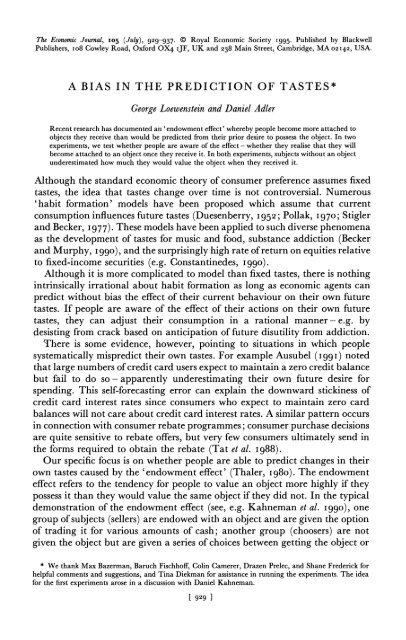
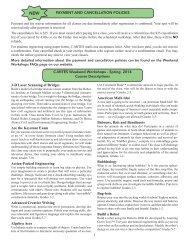
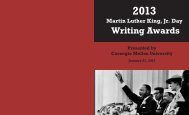
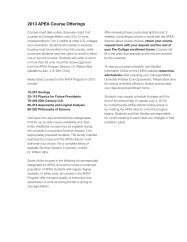

![Pittsburgh Neighborhoods [.pdf] - Carnegie Mellon University](https://img.yumpu.com/22011290/1/190x115/pittsburgh-neighborhoods-pdf-carnegie-mellon-university.jpg?quality=85)
![Curriculum Vitae [.pdf] - Carnegie Mellon University](https://img.yumpu.com/20737100/1/190x245/curriculum-vitae-pdf-carnegie-mellon-university.jpg?quality=85)
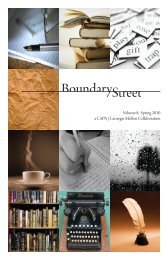
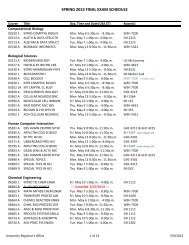
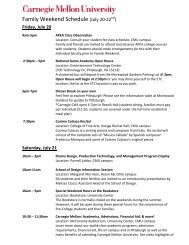
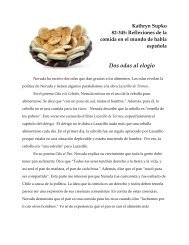


![May 2012 [.pdf] - Carnegie Mellon University](https://img.yumpu.com/12198417/1/190x253/may-2012-pdf-carnegie-mellon-university.jpg?quality=85)
